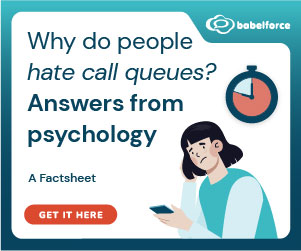Janna Pugh at Five9 explores 7 simple ways to bring better phone etiquette basics into every customer conversation, and make sure the human touch doesn’t get lost in an AI world.
In today’s hybrid contact centres, where live agents work side-by-side with virtual AI assistants and agents, good phone etiquette basics are not just another tool: agent phone etiquette skills are a uniquely human skill that builds trust, solves problems faster, and creates the kind of customer experience people remember for all the right reasons.
Across industries, conversations are playing an increasingly important role in the customer journey. Knowing how to talk to customers – especially when bots are everywhere – is what sets lasting brands apart.
No matter how someone reaches out, whether by phone, chat, or email, the way an agent communicates can make all the difference.
Sure, AI can help move things along faster. But no one, no matter how rushed they are, wants to trade in basic courtesy and empathy just to save a few seconds.
So, what does good phone etiquette actually look like? Call centre telephone etiquette is not just reading from a script. It’s about really getting the person on the other end.
Respecting their time. Listening. Understanding their needs and their feelings. And turning what could be a chore into something a little bit more human.
1. Start With a Warm, Clear Hello
First impressions really do matter. Whether you’re speaking to someone directly or writing the first line of an AI script, a friendly, professional greeting sets the tone.
Keep it simple: introduce yourself, the company name, and ask how you can help. A line like, “Hello, thank you for calling [COMPANY NAME], my name is [NAME]. How can I assist you today?” goes a long way.
2. Listen, Don’t Just Wait to Talk
Good active listening means staying quiet while the other person speaks. It’s about letting them finish, acknowledging their concerns, and even repeating key info back to them to show you’ve understood.
Even something as small as “Let me make sure I’m getting this right…” can make a customer feel truly heard.
3. Keep It Calm, No Matter What
Tension can quickly mount when a customer is feeling frustrated or confused. Staying steady and respectful, even when a caller is upset, can shift the whole tone of the conversation.
Don’t interrupt or mirror their frustration. Something like “I can totally see why this would be frustrating” goes a long way toward building rapport.
4. Be Clear and Honest If You Don’t Know
Being human also means not having the answer every time. And that’s OK. What matters is how you handle it. Speak in plain language, skip the jargon, and if you need to confirm something, be upfront.
Saying, “That’s a great question – let me ask our specialist and get back to you within the hour” shows honesty and commitment to helping.
5. Know Your Customers
A lot of customers have a backstory. Maybe they’ve been loyal to the brand for years. Maybe they’ve already called twice this week and followed up with an email.
Take a second to check their history if you can. Even a little context helps you tailor the conversation and makes people feel like more than just another ticket in a queue.
6. Show You Value Their Time
Time is one of the most personal things a person can give. Be sure to keep things efficient, whether it’s you or your virtual assistant handling the task.
If you need to put someone briefly on hold, make sure you ask them first. If they’ve waited, thank them. Small moments of politeness and acknowledgement quickly add up to a big impression.
7. Leave Things on a Good Note
How you end a call matters just as much as how you start it. Summarize what has been resolved, make sure the customer is clear about next steps, and ask if there’s anything else you can help with.
And of course, don’t forget to thank them for the call. Even on a tough or complex call, a kind and thoughtful closing can make the whole interaction feel more positive.
Why Good Phone Etiquette Basics Still Win in the Age of AI
As conversations become an increasingly critical touchpoint (whether with a human agent or AI assistant), agent phone etiquette skills matter more than ever. It’s what turns a quick and painless resolution into a lasting impression.
In today’s hybrid contact centre, where virtual agents resolve routine questions and human agents step in for more complex enquiries, the way we communicate is what sets brands apart. Courtesy, clarity, and empathy aren’t just nice, they’re expected.
Whether you’re answering calls, managing teams, or shaping how AI responds, remember: good phone etiquette basics, like good customer service, put people first. And in the new CX, that’s always the winning edge.
This blog post has been re-published by kind permission of Five9 – View the Original Article
For more information about Five9 - visit the Five9 Website
Call Centre Helper is not responsible for the content of these guest blog posts. The opinions expressed in this article are those of the author, and do not necessarily reflect those of Call Centre Helper.
Author: Five9
Reviewed by: Jo Robinson
Published On: 25th Sep 2025
Read more about - Guest Blogs, Five9






 Five9 empowers organizations to create hyper-personalized and effortless AI-driven customer experiences that deliver better business outcomes. Powered by Five9 Genius AI and our people, the Five9 Intelligent CX Platform is trusted by 3,000+ customers and 1,400+ partners globally. The New CX starts here and it's at the heart of every winning experience.
Five9 empowers organizations to create hyper-personalized and effortless AI-driven customer experiences that deliver better business outcomes. Powered by Five9 Genius AI and our people, the Five9 Intelligent CX Platform is trusted by 3,000+ customers and 1,400+ partners globally. The New CX starts here and it's at the heart of every winning experience. 































